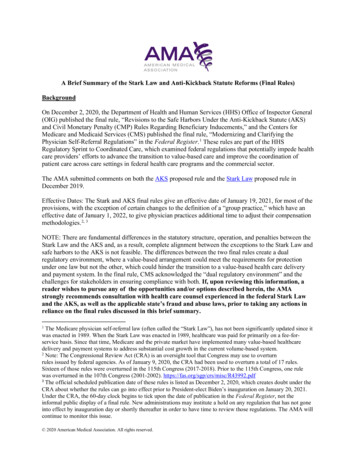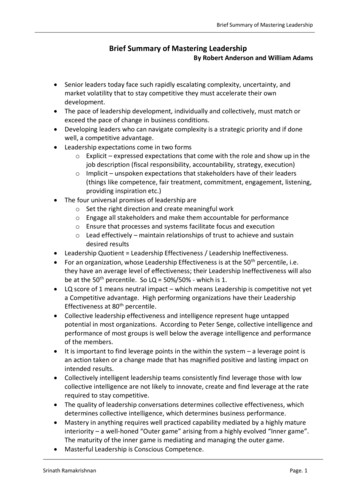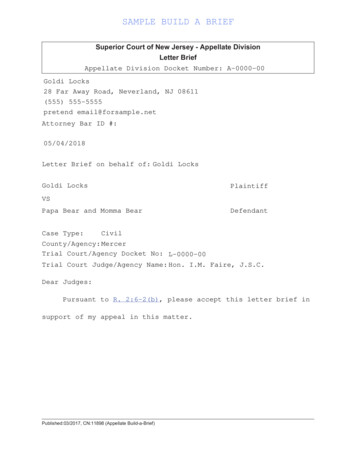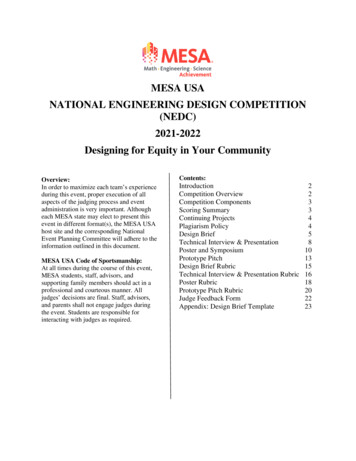
Transcription
A Brief Summary of the Stark Law and Anti-Kickback Statute Reforms (Final Rules)BackgroundOn December 2, 2020, the Department of Health and Human Services (HHS) Office of Inspector General(OIG) published the final rule, “Revisions to the Safe Harbors Under the Anti-Kickback Statute (AKS)and Civil Monetary Penalty (CMP) Rules Regarding Beneficiary Inducements,” and the Centers forMedicare and Medicaid Services (CMS) published the final rule, “Modernizing and Clarifying thePhysician Self-Referral Regulations” in the Federal Register. 1 These rules are part of the HHSRegulatory Sprint to Coordinated Care, which examined federal regulations that potentially impede healthcare providers’ efforts to advance the transition to value-based care and improve the coordination ofpatient care across care settings in federal health care programs and the commercial sector.The AMA submitted comments on both the AKS proposed rule and the Stark Law proposed rule inDecember 2019.Effective Dates: The Stark and AKS final rules give an effective date of January 19, 2021, for most of theprovisions, with the exception of certain changes to the definition of a “group practice,” which have aneffective date of January 1, 2022, to give physician practices additional time to adjust their compensationmethodologies. 2, 3NOTE: There are fundamental differences in the statutory structure, operation, and penalties between theStark Law and the AKS and, as a result, complete alignment between the exceptions to the Stark Law andsafe harbors to the AKS is not feasible. The differences between the two final rules create a dualregulatory environment, where a value-based arrangement could meet the requirements for protectionunder one law but not the other, which could hinder the transition to a value-based health care deliveryand payment system. In the final rule, CMS acknowledged the “dual regulatory environment” and thechallenges for stakeholders in ensuring compliance with both. If, upon reviewing this information, areader wishes to pursue any of the opportunities and/or options described herein, the AMAstrongly recommends consultation with health care counsel experienced in the federal Stark Lawand the AKS, as well as the applicable state’s fraud and abuse laws, prior to taking any actions inreliance on the final rules discussed in this brief summary.The Medicare physician self-referral law (often called the “Stark Law”), has not been significantly updated since itwas enacted in 1989. When the Stark Law was enacted in 1989, healthcare was paid for primarily on a fee-forservice basis. Since that time, Medicare and the private market have implemented many value-based healthcaredelivery and payment systems to address substantial cost growth in the current volume-based system.2Note: The Congressional Review Act (CRA) is an oversight tool that Congress may use to overturnrules issued by federal agencies. As of January 9, 2020, the CRA had been used to overturn a total of 17 rules.Sixteen of those rules were overturned in the 115th Congress (2017-2018). Prior to the 115th Congress, one rulewas overturned in the 107th Congress (2001-2002). https://fas.org/sgp/crs/misc/R43992.pdf3The official scheduled publication date of these rules is listed as December 2, 2020, which creates doubt under theCRA about whether the rules can go into effect prior to President-elect Biden’s inauguration on January 20, 2021.Under the CRA, the 60-day clock begins to tick upon the date of publication in the Federal Register, not theinformal public display of a final rule. New administrations may institute a hold on any regulation that has not goneinto effect by inauguration day or shortly thereafter in order to have time to review those regulations. The AMA willcontinue to monitor this issue.1 2020 American Medical Association. All rights reserved.
Stark Law and AKS Final Rule SummaryDecember 2, 2020Page 2The Physician Self-Referral Law ChangesThe final rule creates new, permanent exceptions to the Stark Law for value-based arrangements. Theexceptions apply regardless of whether the arrangement relates to care provided to Medicare or otherpatients.DefinitionsTarget Patient Population: In the proposed rule, CMS sought public comment on whether it shouldincorporate a requirement that patients in the target patient population have at least one chronic conditionin order to align with OIG’s proposals. In the AMA’s comment letter, we voiced our opposition to CMS’proposal to limit a target patient population to patients with at least one chronic condition. Consistentwith the AMA’s request, CMS is not limiting a target patient population to patients with at leastone chronic condition. As finalized, target patient population means an identified patient populationselected by a value-based enterprise (VBE) or its VBE participants based on legitimate and verifiablecriteria that are set out in writing in advance of the commencement of the value-based arrangement andfurther the value-based enterprise’s value-based purpose(s).Designated Health Services: In alignment with the AMA’s comments, CMS revised the definition ofdesignated health services to exclude inpatient services paid for under prospective payment systemsif furnishing those services does not increase the amount of Medicare’s payment to the hospital. Inthe final rule, CMS declined to expand the modified definition to outpatient hospital services.Physician: CMS finalized the definition of “physician” as proposed. The revised definition aligns theregulatory definition of “physician” at 42 Code of Federal Regulations (CFR) §411.351 4 with thestatutory definition of “physician” in §1861(r) of the Social Security Act 5 to ensure that there are noinconsistencies between the two. Under the statutory definition, a “physician” includes a doctor ofmedicine or osteopathy, a doctor of dental surgery or dental medicine, a doctor of podiatric medicine, adoctor of optometry, and a chiropractor, but provides for certain limitations on when such doctors areconsidered “physicians.” CMS clarifies in the final rule that it does not believe that the definition of“physician” in the regulations should be either more limited or more expansive than the statutorydefinition. Therefore, CMS states, that to the extent that the statutory definition of “physician” includesdoctors other than doctors of medicine and osteopathy, those practitioners fall within the ambit of thephysician self-referral law.New Compensation ExceptionsValue-Based Care Exceptions: The final rule creates new, permanent exceptions to the Stark Law forvalue-based arrangements. The exceptions apply regardless of whether the arrangement relates to carefurnished to people with Medicare or other patients. The new value-based exceptions largely mirror theproposed rules, with some changes favorable to physicians. Consistent with the AMA’s request, in thefull financial risk exception CMS has extended the “pre-risk” period from six months as proposed,to 12 months. With regards to the meaningful downside financial risk exception, the final rule requiresthe physician be responsible to pay or forego no less than 10 percent, rather than paying 25 percent asproposed, of the value of the remuneration the physician receives under the value-based arrangement.Regulatory Definition of Physician, 42 CFR §411.351. “Physician means a doctor of medicine or osteopathy, adoctor of dental surgery or dental medicine, a doctor of podiatric medicine, a doctor of optometry, or a chiropractor,as defined in section 1861(r) of the Act. A physician and the professional corporation of which he or she is a soleowner are the same for purposes of this subpart.” atutory Definition of Physician, 42 U.S. Code §1395x(r), https://www.law.cornell.edu/uscode/text/42/1395x.4 2020 American Medical Association. All rights reserved.
Stark Law and AKS Final Rule SummaryDecember 2, 2020Page 3New Exception for Limited Remuneration to a Physician: The AMA is pleased that CMS finalized anew exception to protect compensation not exceeding an aggregate of 5,000 per calendar year(increased from 3,500 as proposed), adjusted for inflation, to a physician for the provision of itemsand services without the need for a signed writing and compensation that is set in advance if certainconditions are met. The rule also permits the physician to provide the items or services in questionthrough employees the physician hired for the purpose of performing the services, a wholly owned entityor locum tenens physicians.Other: The AMA, along with several other public commenters, urged CMS to create an exception forvalue-based arrangements that is exclusively available to rural providers and small physician practices. Inthe final rule CMS acknowledged the challenges faced by rural providers and small physician practicesbut declined to create the requested exception.New Exception for Cybersecurity Technology and Related Services: New Exception for CybersecurityTechnology and Related Services: CMS finalized a new exception to protect arrangements involvingthe donation of certain cybersecurity technology and related services, including certaincybersecurity hardware donations. Note, that this is separate from the electronic health recordsexception clarification by CMS, which in the final rule expressly permits donations of cybersecuritysoftware and services that protect electronic health records under the EHR exception. In response toAMA advocacy, CMS declined to limit the types of donors protected under this exception; instead,the final rule protects all donors. This supports a broad scope of protected donors, including individualsor entities, hospitals, health plans, EHR vendors, manufacturers, and ancillary service providers. Giventhe complexity of cybersecurity, donations may also include training services, such as training aphysician’s staff on how to use the cybersecurity technology, how to prevent, detect, and respond to cyberthreats, and how to troubleshoot problems with the cybersecurity technology. Physicians and their staffmay also be provided access to a donor’s primary technology help desk (for example, to reportcybersecurity incidents).Guidance and ClarificationsClarifications to “Group Practice” Requirements: CMS finalized clarifications to the regulationsdefining a “group practice” for purposes of the Stark Law. While the profits from all designated healthservices (DHS) of any component of the group that consists of at least five physicians (which may includeall physicians in the group) must be aggregated before distribution, CMS clarified that a group practicemay utilize different distribution methodologies to distribute shares of the overall profits from all DHS ofeach of its components of at least five physicians, provided that the distribution to any physician is notdirectly related to the volume or value of the physician’s referrals and the same methodology is used forall the physicians included in their component. As noted above, CMS delayed the effective date for thisportion of the rule to January 1, 2022, to give physician practices additional time to adjust theircompensation methodologies.Clarification for Electronic Health Records (EHR) Items and Services Exception: The AMA voicedsupport for the concept of updating the exception to recognize the significant updates regardinginformation blocking but raised questions and voiced concerns regarding how such a provision wouldwork in the EHR exception. CMS finalized many proposed changes to this exception however, CMS didnot finalize its proposal to modify the provision addressing the concept of information blocking andinstead removed that provision from the exception due to the significant questions raised by commenters. 2020 American Medical Association. All rights reserved.
Stark Law and AKS Final Rule SummaryDecember 2, 2020Page 4The AKS ChangesThe AKS final rule finalizes many of OIG’s proposals that modify existing AKS safe harbors, create newAKS safe harbors, and create a new CMP law exception.New AKS Safe HarborsValue-Based Arrangements: The OIG finalized three new safe harbors to protect certain payments amongindividuals and entities in a value-based arrangement. The three new safe harbors vary in terms of thetype of remuneration that can be provided, the level of financial risk the parties assume (full financialrisk, substantial downside financial risk, and no or lower risk), and the types of safeguards required tosatisfy the safe harbor. Overall, the value-based safe harbors are generally narrower than the Starkexceptions. The OIG has stated that entities ineligible to use the value-based safe harbors are:pharmaceutical manufacturers, distributors, and wholesalers; pharmacy benefit managers (PBMs);laboratory companies; pharmacies that primarily compound drugs or primarily dispense compoundeddrugs; manufacturers of devices or medical supplies; entities or individuals that sell or rent durablemedical equipment, prosthetics, orthotics and supplies (DMEPOS) (other than a pharmacy or a physician,provider, or other entity that primarily furnishes services); and medical device distributors andwholesalers. However, the OIG carved out a separate, limited pathway for certain medical devicemanufacturers and durable medical equipment companies to participate in protected care coordinationarrangements that involve digital health technology, provided that certain requirements are met.The AMA voiced our opposition to the proposal requiring that a VBE have a compliance program,requiring that all VBE participants affirmatively recognize the oversight role, having more specificresponsibilities on the accountable body or responsible person, implementing reporting requirements ormechanisms for obtaining access to participant data, and imposing a standard requiring eitherindependence or a duty of loyalty. The AMA voiced our understanding for the need for accountability andfor compliance programs but argued that the proposals unnecessarily create additional burden withoutsubstantially reducing the risk of program fraud and abuse. Consistent with the AMA’s comments, theOIG decided that for purposes of these safe harbors in the final rule, the OIG will not require theVBE or its accountable body or responsible person to have a compliance program or to reviewpatient medical records periodically. The OIG will also not be requiring an attestation or otheragreements from each VBE participant that it has a compliance program and conducts annual compliancereviews.Patient Engagement and Support: OIG finalized a safe harbor to protect furnishing certain tools andsupport to patients in order to improve quality, health outcomes and efficiency. Importantly, this safeharbor is only available for value-based enterprise participants. The remuneration can be in-kind only andis limited to a 500 annual cap, adjusted for inflation, along with many other requirements.CMS-Sponsored Models: OIG finalized a safe harbor to protect certain remuneration provided inconnection with certain models sponsored by CMS, thereby reducing the need for HHS to issueindividualized fraud and abuse waivers for each model.Cybersecurity Technology and Services: OIG finalized a standalone protection for donations ofcybersecurity technology and services, including certain cybersecurity hardware donations. 2020 American Medical Association. All rights reserved.
Stark Law and AKS Final Rule SummaryDecember 2, 2020Page 5Modifications to Existing AKS Safe HarborsPersonal Services and Management Contracts Safe Harbor: The OIG finalized a new provision to theexisting personal services and management contracts safe harbor which protects payments tied toachieving measurable outcomes that improve patient or population health or appropriately reduce payorcosts.Local Transportation: The OIG finalized its proposal to expand and modify mileage limits applicable topatient transportation in rural areas (expanded from 50 to 75 miles) and patient transportation frominpatient facilities post-discharge (removed all mileage limits). The OIG did not extend safe harborprotection to transportation of patients to any location of their choice or for nonmedical purposes.Electronic Health Records Items and Services Safe Harbor: Like CMS, the OIG finalized severalproposed changes to this safe harbor, including modifying the timing of certain required recipientcontributions, permitting certain donations of replacement technology and removing the sunset provision.The OIG also did not finalize its proposal to modify the provision addressing the concept of informationblocking, and instead removed that provision from the safe harbor entirely.Warranties: OIG finalized its proposal to expand the warranty safe harbor to protect warranties covering abundle of one or more items and related services.Accountable Care Organization (ACO) Beneficiary Incentive Programs: The OIG amended the civilmonetary penalty (CMP) rules by codifying a revision to the definition of “remuneration” added by theBipartisan Budget Act of 2018.New CMP ExceptionTelehealth for In-Home Dialysis: The OIG finalized its proposal to interpret and incorporate theBipartisan Budget Act of 2018 statutory exception for furnishing telehealth technologies to certain inhome dialysis patients.***DISCLAIMER: The information provided in this document is believed to be current and accurateat the time of posting. This information is not intended to be and should not be construed to be orrelied upon as, legal, financial, or consulting advice. These rules are highly technical; as such, youshould consult with an experienced health care attorney to obtain guidance relating to your specificsituation. References and links to third parties do not constitute an endorsement, sponsorship, orwarranty by the AMA, and the AMA hereby disclaims all express and implied warranties of anykind. 2020 American Medical Association. All rights reserved.
1 The Medicare physician self-referral law (often called the "Stark Law"), has not been significantly updated since it was enacted in 1989. When the Stark Law was enacted in 1989, healthcare was paid for primarily on a fee-for-service basis. Since that time, Medicare and the private market have implemented many value-based healthcare











